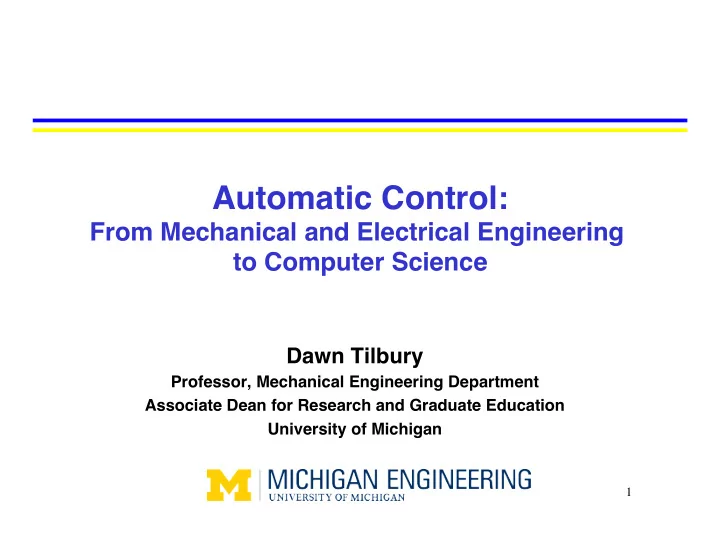

Automatic Control: From Mechanical and Electrical Engineering to Computer Science Dawn Tilbury Professor, Mechanical Engineering Department Associate Dean for Research and Graduate Education University of Michigan 1
Control systems • Plant to be controlled, defined by differential equations: – Actuation (input) – u(t) – Sensing (output) – y(t) – Desired behavior (reference) – r(t) • Design a controller to achieve desired behavior – Given the error e = r-y, compute the input u 2
Challenges to be addressed • How to find the reference input for the low- level controller? • How to represent the desired action? – Can physics be leveraged to improve performance? • How to interpret the information that is coming from the low-level sensors? – Aggregation and abstraction 3
Information based control • Control at every Make decisions Interpret level is built on models models Update Predict – How can they be models outcomes adapted as things y = Ax + Be change? x = f ( x , u ) ˙ Model system Understand • Different levels of behavior anomalous data abstraction – What are the Pre-process appropriate data Guide data interfaces collection between levels? 4
Crossing boundaries • ASME DSCD TC on Robotics: Control applications in robotics; mobile robots and mobile robot collectives; biomimetics, bio-mechanical, humanoid robots, human-machine interface • ASME DED TC on Mechanisms and Robotics: design and applications of mechanisms, machines, robots and mechatronics systems. • IEEE CSS TC on Manufacturing Automation and Robotic Control • IEEE Robotics and Automation Society 5
h"p://robo)cs.umich.edu ¡
Robotics Initiative at Michigan • New MS/PhD program in Robotics: Fall 2014 – 5 new PhD students, 3 new MS students – Two new graduate courses: Math for Robotics and Robot Systems (hands-on) • Robotics Day: 5 th annual – April 9, 2015 – More than 500 attendees in 2014, including FIRST robotics, industry members, university students • Connected and autonomous vehicles, rehabilitation robotics, and many more…
Recommend
More recommend